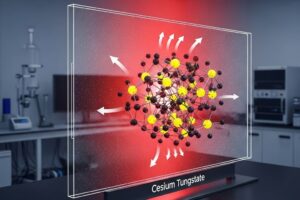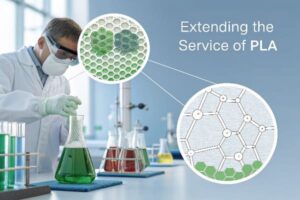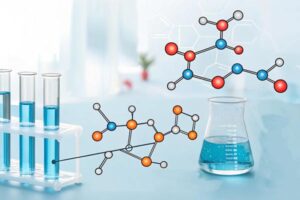As environmental regulations tighten globally, water-based coatings and adhesives are increasingly replacing solvent-based systems in industrial packaging, printing, lamination, and more. While offering clear environmental and safety benefits, water-based systems often struggle with:
- Insufficient water and heat resistance
- Inconsistent adhesion on complex substrates
- Weak mechanical integrity due to low crosslinking density
To address these challenges, functional crosslinkers are introduced to enhance performance. Among the emerging solutions, Polycarbodiimide (PCDI) has gained widespread attention due to its non-toxic profile, high reactivity, and excellent compatibility with various polymer systems. PCDI enables durable, high-performance crosslinking in waterborne systems—without the use of toxic isocyanates.
1. Reaction Mechanism of Polycarbodiimide
PCDI is a polymer that contains multiple carbodiimide functional groups (–N=C=N–) along its backbone. These reactive sites readily undergo addition reactions with carboxyl groups (–COOH) commonly found in water-based resins such as polyurethane dispersions, acrylic emulsions, alkyds, and PVA copolymers.
🔬 Primary Crosslinking Reaction:
R–N=C=N + R’–COOH → R–NH–CO–R’
- Reaction Type: Nucleophilic addition
- Bond Formed: Urea linkage (–NH–CO–)
- Conditions: No catalyst required; occurs at ambient or elevated temperatures
- By-products: None – clean reaction with no gas or volatile emissions
This crosslinking reaction leads to the formation of a three-dimensional polymer network, greatly enhancing film integrity, chemical resistance, and thermal stability.
Additional Reaction Paths:
- With Water: In humid environments, carbodiimide groups may slowly react with water to form urea derivatives. While slower, this can lead to minor crosslinking over time.
- Multi-point Crosslinking: Due to its polymeric structure, PCDI contains multiple functional sites capable of interlinking multiple chains, enhancing toughness and cohesion.
2. Key Features of PCDI
| Feature | Benefit |
|---|---|
| Non-toxic, isocyanate-free | Safe for production, handling, and end-use applications |
| Low migration | Permanently bonded in polymer matrix; doesn’t leach |
| Broad compatibility | Works with PU, acrylic, PVA, alkyd, and hybrid emulsions |
| Thermal & hydrolytic stability | Ideal for heat-resistant or high-moisture applications |
| Reactive yet storage-stable | Long shelf life under dry conditions; slow moisture sensitivity |
| Low viscosity | Easy to handle and disperse into water-based systems |
3. Application Benefits in Coatings and Adhesives
1. Enhanced Water and Chemical Resistance
Crosslinking with PCDI produces denser film structures that resist swelling, water penetration, and chemical attack. This makes it ideal for:
- Industrial packaging coatings
- Paper and board barrier coatings
- Protective films for plastic and metal surfaces
2. Improved Adhesion and Mechanical Strength
PCDI boosts both internal cohesion and substrate adhesion in adhesives. It enhances peel strength, heat resistance, and long-term bonding stability in:
- Film-to-film lamination
- Plastic-metal composites
- Pressure-sensitive adhesives (PSAs)
3. Thermal Durability
Crosslinked films using PCDI can withstand elevated processing temperatures, such as heat sealing or oven curing. Unlike some waterborne adhesives that fail at high temperatures, PCDI crosslinked systems remain intact.
4. Enhanced Performance in Inks and Overprint Varnishes
In water-based ink formulations and clear coatings, PCDI improves:
- Scratch resistance
- Gloss retention or matte uniformity
- Resistance to solvents, abrasion, and aging
It is well-suited for electronics packaging, labeling, and high-end printing applications requiring both aesthetics and durability.
4. Usage Guidelines
- Recommended dosage: 1–5% based on resin solids
- Addition method: Add at the final stage of formulation; avoid mixing directly with free water
- Curing: Can crosslink at room temperature or during thermal drying (60–120°C)
- Storage: Store in sealed containers in dry environments; moisture exposure may initiate slow pre-reactions
- Compatibility: Suitable for anionic, nonionic, and some cationic systems
5. Example Applications
| Application Area | Use Case |
|---|---|
| Industrial coatings | Protective coatings on metal, plastic, or composites |
| Lamination adhesives | Waterborne adhesives for PET/PE, OPP/AL/PE film layers |
| PSA labels | High-performance label adhesives with moisture resistance |
| Clear topcoats | Gloss or matte overprint varnishes for packaging or electronics |
| Functional paper coatings | Water/oil-resistant coatings for paperboard or carton packaging |
6. Conclusion
Polycarbodiimide (PCDI) represents a next-generation crosslinking solution that bridges the performance gap in waterborne systems—without compromising on safety or sustainability. Its ability to form strong, non-toxic, and permanent crosslinks under mild conditions makes it an ideal additive for today’s eco-conscious formulation needs.
From adhesives and coatings to inks and laminates, PCDI enhances durability, stability, and functionality—supporting the transition to high-performance water-based technologies across industries.







